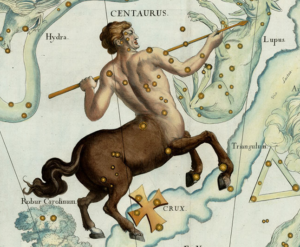
The constellation Crux, the Southern Cross, is a constellation in the southern hemisphere of the sky. It is only visible from latitudes south of 27 degrees. It is completely below the horizon in most parts of the northern hemisphere. It is the smallest constellation in the night sky with a total area of only 68 square degrees. It is bordered by the constellations Centaurus on the east, north and west, and Musca to the south. Crux is one of the most familiar constellations in the southern hemisphere. It is an easy constellation to identify, due to its obvious cross shape and bright stars. Since the southern hemisphere does not have a bright star near its pole, Crux was used by sailors as a navigational aid. They would draw a line using the stars in the cross in order to determine the location of the south celestial pole, which is actually located in the constellation Ocatans.
Crux was considered to be part of the constellation Centaurus by the Greek astronomer Ptolemy in the second century. The Greeks were able to see the celestial cross before it disappeared below the horizon due the procession of the Earth’s axis. Some linked the disappearance of the cross with the crucifixion of Christ. By the year 400, the stars were no longer visible from Europe. The Dutch astronomer Petrus Plancius was the first to separate the stars into their own constellation in 1592. The Southern Cross carried special significance for many cultures in the southern hemisphere. The ancient Inca knew the constellation as Chakana, which means “the stair”. The Mori called it Te Punga, which meant “the anchor.” To the ancient aboriginal people of Australia, it represented part of the head of the Emu in the Sky. It is represented on the Australian flag and on the flag of Brazil.
- Symbolism: Southern Cross
- Right ascension: 12.5h
- Declination: −60°
- Quadrant: SQ3
- Area: 68 sq. deg. (88th)
- Main stars: 4
- Bayer/Flamsteed stars: 19
- Stars with planets: 2
- Brightest star: Acrux (α Cru) (0.87m)
Crux Mythology
Ancient Greek peoples considered the Crux constellation as part of the Taurus constellation. This is evidenced in Claudius Ptolemy’s famous Almagest written in the 2nd century. His work was a recording of the constellations, but in it, Crux is not mentioned. Instead, the stars of Crux are labelled within Taurus. This is why there is no known Greek mythical figure associated with the Crux constellation.
Nevertheless, the Crux constellation – which is also called the Southern Cross – has significant importance to peoples in the Southern Hemisphere. The famous Machu Picchu area in the Andes mountains is home to a historic stone carving of the Crux constellation. In Australian aboriginal astronomy, part of the constellation is used to create an Emu and the cross features on the national flag. Whereas in Brazil, the constellation gets an honorary mention in its national anthem – and is also seen on the national flag.
It appears that the crux constellation was not as recognized or treasured in countries in the Northern Hemisphere as it was in the south. This has resulted in fewer (European) mythologies associated with it.
